The 100 Percent Clean Energy Economy Is Closer than You Think
Solar panels on every roof, smart houses, and networked cars: A glimpse into the clean energy future on the horizon.
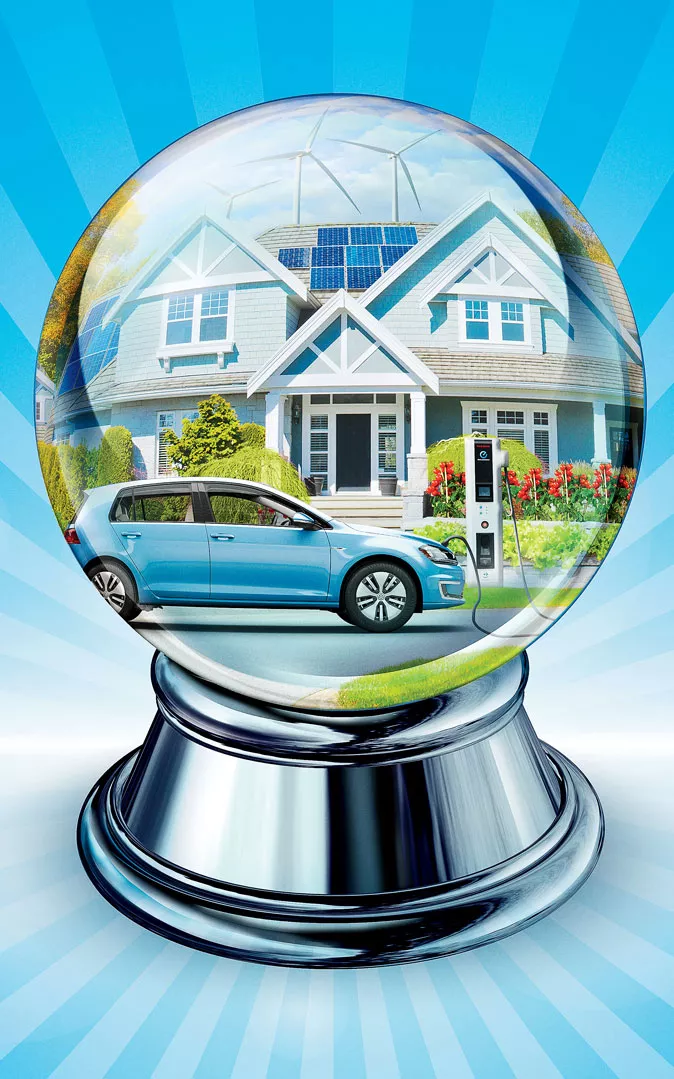
Illustration by Aaron Goodman
Imagine: Your workday is done, and when you walk to the parking lot, the first thing you do is unplug your vehicle from the office building where it's been soaking up electricity from rooftop solar panels all day. You hit the road and, as usual, there are no delays. With all the cars networked together, traffic moves seamlessly, like a flock of birds, using as little energy as possible. On the ride home, you switch to autopilot so you can check your phone to see how your house has been performing. The rooftop panels there have also been cranking all day, but a lot of their power has gone to the grid, so the home battery isn't fully charged. No worries—the vehicle battery can top it off later. You activate your home air-conditioning, which has been in sleep mode while you were out, and, with a swipe of a screen, begin preheating the oven. You look up as you round the bend: There are windmills spinning on the ridgeline.
Is this scenario science fiction? Not as much as you might think. "The future has already arrived," the writer William Gibson once said. "It's just not evenly distributed yet." The same is true of America's impending low-carbon future.
Rooftop solar panels on homes and businesses. Batteries that can power smart, energy-efficient homes. Electric cars and self-driving vehicles. These emerging technologies are with us now. But they're scattered and not yet at scale, and they remain pricey in some cases, all of which can make them difficult to see.
The clean energy economy is poorly distributed, in part, because of the political stalemate in Washington, D.C., where climate change remains a highly polarized issue. But outside of D.C., local leaders from across the political spectrum are preparing for a low-carbon future. Businesses are also joining the effort. Hyperefficient, clean energy technologies are attracting major investment—at least $310 billion globally in investor capital in 2014, a fivefold increase from a decade earlier—evidence that you don't have to be an environmentalist to believe that the greening of the United States is a profitable business opportunity.
"Local solutions are where the real opportunity lies and where the innovation is happening," says Tyler Nickerson of the Solutions Project, a nonprofit cofounded by Mark Jacobson, a Stanford University scientist whose work has helped guide state and local climate plans. "States can do a great deal, and cities can do a lot," Jacobson says.
Jacobson has developed a blueprint that shows how the United States and the rest of the world can eliminate fossil fuels and transition to 100 percent renewable energy by 2050. His plan for the United States relies on solar, wind, and water to generate all the electricity we need. Fully electrified systems for transportation, heating and cooling, and industrial energy use will make other fuels obsolete.
Does that sound ambitious? It is. And—here's the beauty—it's also achievable. Already, a handful of small cities—Burlington, Vermont; Aspen, Colorado; and Greensburg, Kansas—get all their electricity from renewable energy. Another 12 communities—from Grand Rapids, Michigan, to Georgetown, Texas—have pledged to do so. Earlier this year, the Sierra Club launched its Ready for 100 campaign, which aims to enlist more cities to make a 100 percent clean energy commitment.
So far, the biggest city to set a 100 percent clean energy goal is San Diego. The move by the country's eighth most populous city is precedent setting. For starters, its climate action plan is legally binding, not just a vaguely worded proclamation. Also, the effort was bipartisan and gained the support of the Republican mayor, Kevin Faulconer, and the Democratic city council. Even San Diego Gas & Electric, the local utility company, agreed—albeit reluctantly and at the last minute—not to oppose the plan.
In his 2016 State of the City address, Mayor Faulconer cited the climate action plan as one of his proudest accomplishments: "Business groups. Environmentalists. Democrats. Republicans. SDG&E, an industry leader on renewable energy. We brought them all to the table and united around a common-sense plan for a greener and more prosperous future." Faulconer says the plan will create new jobs in the renewable energy industry, improve public health and air quality, conserve water, and save the government money.
San Diego is a potent symbol of the energy transition because it is emblematic of our automobile-centric landscapes. Thanks to their higher population densities, older cities such as New York and Chicago are much greener than newer cities in the South and West, suburbs, and rural areas. The average carbon footprint of households living in big, dense cities is about 50 percent below the U.S. average.
In comparison, San Diego's 1.4 million people sprawl across some 370 square miles from the Pacific coast to the inland deserts. The place represents the challenges, and the opportunities, of making the suburbs sustainable—a crucial goal, given that half of all Americans say they live in suburbia. Suburbs—or suburb-like cities such as San Diego, Phoenix, and San Antonio—pose a tough task. Huge single-family homes, gas-guzzling sport-utility vehicles, long commutes, clogged thoroughfares, strip malls, parking lots, and wide expanses of lawn that soak up water and fertilizer: The combination is awful for the planet. To reach the 100 percent clean energy goal, suburbs are going to have to change—and they already are.
"San Diego is a big, spread-out city with a lot of residential neighborhoods and low buildings," says Jodie Van Horn, who directs the Sierra Club's Ready for 100 campaign. "It's got a lot of rooftops to fill. So the implementation of 100 percent clean energy with a big emphasis on solar has a lot of potential there, and we hope San Diego will inspire other cities to follow suit."
If you look closely, you can glimpse the beginnings of tomorrow's low-carbon suburbs.
Nearly 40 years after President Jimmy Carter installed an array of bulky solar panels on the White House roof, solar technology is experiencing a breakthrough moment. Rooftop photovoltaic solar is booming, and in the first three quarters of 2015, the solar industry represented about 30 percent of all new electricity-generating capacity in the United States.
San Mateo, California-based SolarCity, the nation's leading rooftop installer, has operations in 27 states, employs more than 15,000 people, and has 300,000 customers, and it's just getting started, says Lyndon Rive, the CEO. "Homes are going to be providing energy to themselves and also to their neighbors and to their communities, perhaps even in the next zip code," Rive says.
As part of Jacobson's plan for a zero-carbon America, electricity will still be produced at big, centralized facilities—hydropower in the Pacific Northwest, concentrated solar in the Southwest and Florida, wind farms in Texas and the Great Plains, offshore wind in the Northeast. But a significant slice of energy generation (about 40 percent of the nation's needs) will shift to the rooftops of homes and businesses or to utility-scale photovoltaic solar installations.
This shift toward decentralization is already under way. Just as mainframe computers have given way to desktops and laptops, and landlines are being replaced by mobile phones, distributed solar is poised to replace power plants that burn fossil fuels. Environmental advocates and some policy experts say that using existing buildings to generate electricity is more efficient and has fewer effects on open spaces (compared with utility-scale solar operations, some of which have proved controversial).
Lower prices are a significant factor driving the growth, along with the option to lease rather than buy panels, which eliminates up-front costs of $15,000 or more. A Deutsche Bank analysis of the solar industry predicted that rooftop solar will be the lowest-cost electricity option for most people in the United States by the end of 2016, particularly if utilities continue to raise electricity prices. Most homeowners say that saving money is a big reason why they go solar.
Shifts in public policy are helping to drive rooftop solar's success. For example, San Diego's 100 percent clean energy plan relies on a bold idea known as community choice aggregation, or CCA. Under such a system, decision-making about electricity generation (which has always been left up to the utilities) is done by city officials, who set the electricity rates and decide where the power will come from, while the utility continues to operate the transmission lines and manage the electrical grid. The elected officials can be held accountable to voters—who, presumably, prefer clean energy to dirty fossil fuels.
CCAs already provide green power in Sonoma and Marin Counties in California as well as in Cleveland, Ohio, and Lowell, Massachusetts. More than 2.4 million customers across the United States get their energy from CCAs. "We needed a mechanism to break away from the utility," says Nicole Capretz, an environmental advocate who helped write San Diego's plan and now leads the nonprofit Climate Action Campaign. Unlike an investor-owned utility, the CCA will be "mission driven and nonprofit," she says, meaning it will prioritize investments in renewable energy.
There is one obvious challenge to this bright future: A heavy reliance on solar power means that electricity has to be stored somewhere for cloudy days and for use at night. Building better batteries could transform how we produce energy. Cheaper and more powerful batteries will go a long way toward liberating homes from the need to use fossil fuel power from the grid. Homeowners will become energy producers and managers as well as consumers.
That, at least, is the vision of Enphase Energy, a California firm that has begun to sell what it calls a Home Energy Solution, which integrates solar panels, batteries, a smart thermostat, and a software platform that enables homeowners to remotely monitor and manage their energy use. "In the long run, everything moves to a distributed architecture," says Raghu Belur, the company's cofounder and director of strategy. "More and more intelligence gets pushed to the periphery of the network."
Tesla, too, has entered the home energy storage market. The company says it will invest $2 billion by 2020 in what it calls a "Gigafactory" near Sparks, Nevada, to produce batteries for its electric cars and for homes. Last fall, the company began selling its seven-kilowatt-hour Powerwall home battery, a unit with enough capacity, the company says, to power homes during the night with energy collected by day. Some experts believe that suburban rooftops will eventually generate so much electricity that they will send the surplus to cities via the batteries of electric vehicles.
Putting solar panels on the roof of a home makes little sense if the electricity is wasted. Fortunately, American homes are becoming much more energy efficient. The average U.S. home today uses 31 percent less energy per square foot than it did in 1970. Unfortunately, homes have also grown 28 percent bigger since then, wiping out most of those gains. If we're going to reach the 100 percent goal, we'll have to break our appetite for super-size dwellings. Some home builders have already gotten the message. One example is Maple Lawn, a planned community midway between Washington, D.C., and Baltimore. In the last decade, developers have built about 900 homes in the community, which also includes offices, restaurants, retail stores, and medical services. Big lawns are rare. Instead, people gather in shared playgrounds and pocket parks.
The newest homes in the development stand out for their efficiency. They rely on geothermal energy systems, which use steady underground temperatures to provide lower-cost heating and cooling, and they are wired for solar. The homes score a rating of just 21 on the Home Energy Rating System index, a way of calculating energy performance. In comparison, a standard new home generally gets a rating of about 100, while older homes are rated as high as 150. The ultimate goal? Get homes to zero, which means the buildings produce as much energy as they use.
Ensuring that these pockets of innovation are evenly distributed among all communities won't be easy. For now, many clean energy technologies remain prohibitively expensive for too many U.S. residents. But on this front, too, there are signs of progress. One residential rooftop solar company that operates in the Northeast and Louisiana, PosiGen, has cracked the code on leasing panels to lower-income families while still turning a profit. In Minnesota, where many utilities are organized as local cooperatives, community solar gardens offer residents a chance to buy a green energy "subscription" and tap into clean energy produced by medium-scale plants located in their area. As these and similar companies grow in size, they will be generating local jobs along with clean energy.
Engineers and entrepreneurs can do their part to ensure that the clean energy economy benefits everyone. But ultimately, political organizing and policy reform will be needed to drive change. Near the top of the list is ensuring that polluters have to pay for dumping carbon into the atmosphere. The rooftop solar panels, the smart homes, the highly efficient batteries, and the electric vehicles—all of them will spread more rapidly to the mainstream once there's a price to be paid for emitting greenhouse gases.
"The most important thing we need is a price on carbon," SolarCity's Rive says. "Right now, fossil fuels get to pollute for free." But the Republicans who control Congress are loath to tax or regulate greenhouse gases—which is exactly why the local leadership and homegrown solutions are so important. They are laying the foundation for a future that remains in the near distance, at least for now.
But history offers a consolation of sorts. More often than not, social change comes with unlikely speed and from unexpected directions. If people can be persuaded that a clean energy economy means more jobs, less pollution, better health, and, ultimately, a more attractive way of life, the transition could happen more quickly than expected. And the unglamorous work of, say, reforming utility regulations will, in hindsight, look like a no-brainer.
"True leadership means setting an ambitious goal and then working toward it, even if you don't know today how exactly you're going to get there," Van Horn says. "The technology's here. The economics are here. The only thing missing is the political will."
This article was funded by the Ready for 100 campaign.
WHAT YOU CAN DO
How green is your city? Visit readyfor100.org to find out how much clean energy your city currently gets and sign a petition asking your mayor to commit to 100 percent clean energy. Go solar at home! Visit sierraclub.org/solar to find out if your home is eligible for inexpensive solar panels through one of the Sierra Club's solar partners.
Coming Soon to a Neighborhood Near You
The Sierra Club has an ambitious vision of reaching a 100 percent clean energy economy by 2050. Achieving that goal will require not just changing how and where we generate electricity (goodbye big, dirty coal plants; hello distributed solar and wind) but also using a lot less of it. That, in turn, will mean making changes to our homes, neighborhoods, and transportation systems. Pie in the sky? Not at all. Clean energy technologies are off-the-shelf and shovel-ready, and just waiting to be adopted on a large scale. —M.G.
BRIGHT IDEA
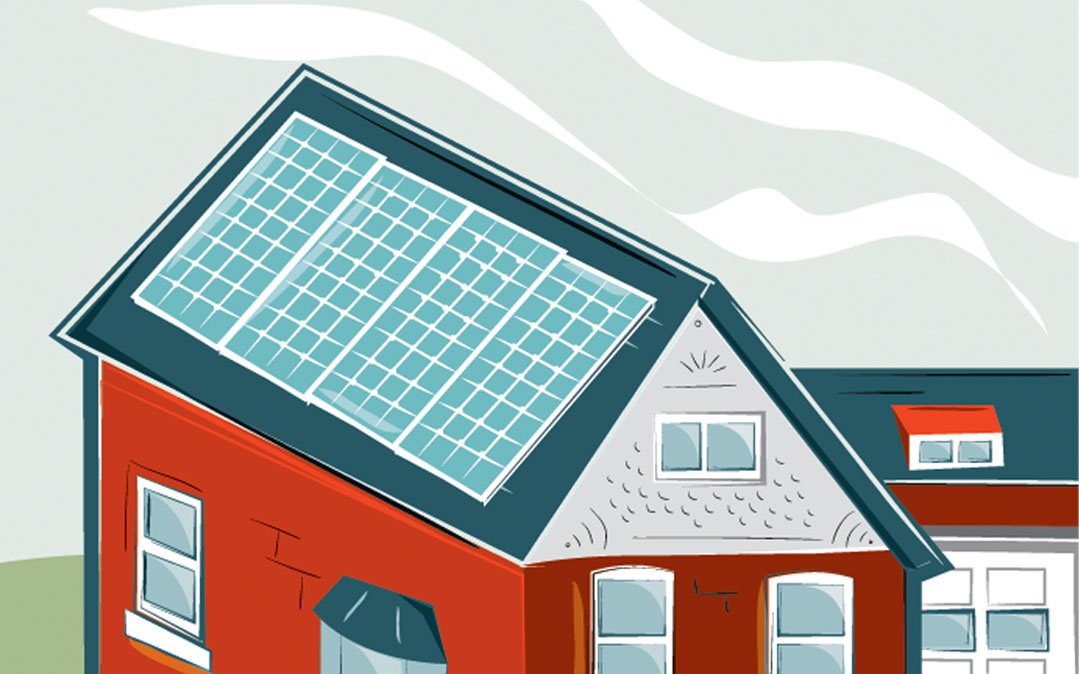 No technology is driving the greening of suburbia faster than rooftop solar, largely owing to plummeting prices. By the end of 2016, rooftop solar will reach price parity with fossil fuel electricity in most areas of the United States, a Wall Street firm has said.
No technology is driving the greening of suburbia faster than rooftop solar, largely owing to plummeting prices. By the end of 2016, rooftop solar will reach price parity with fossil fuel electricity in most areas of the United States, a Wall Street firm has said.
SAVING FOR A RAINY DAY
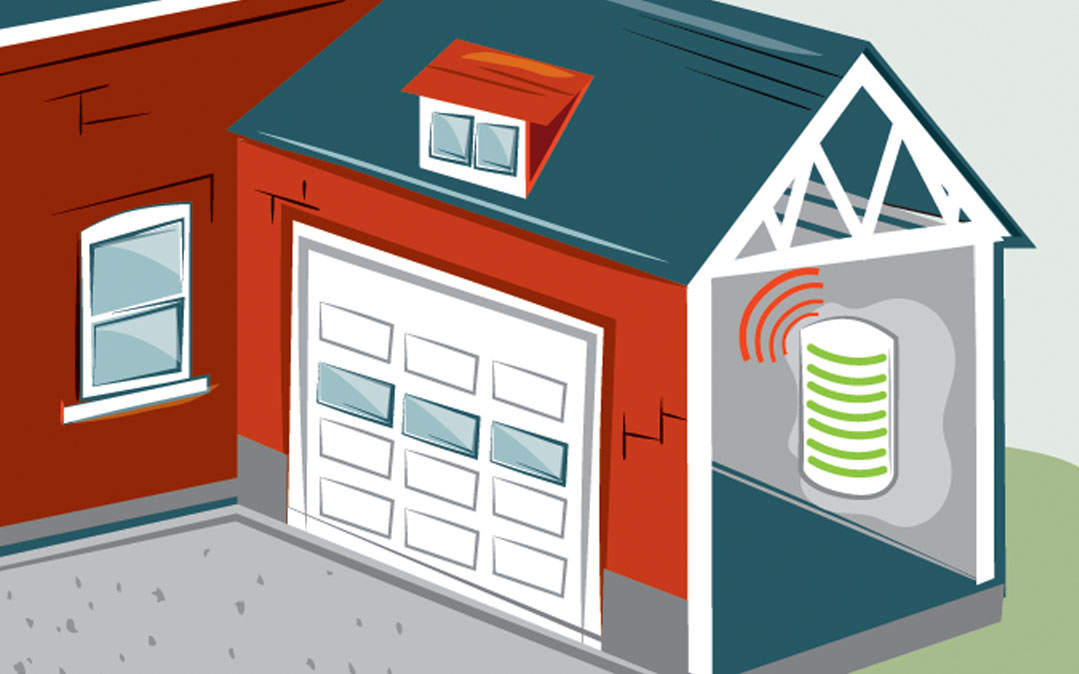 Solar panels are great, but they don’t work when the sun is not shining. Fortunately, a new generation of cheaper, more powerful batteries is on its way. in 2015, tesla unveiled a home battery that costs about $3,000, plus installation—a fraction of what some people spend on a kitchen makeover.
Solar panels are great, but they don’t work when the sun is not shining. Fortunately, a new generation of cheaper, more powerful batteries is on its way. in 2015, tesla unveiled a home battery that costs about $3,000, plus installation—a fraction of what some people spend on a kitchen makeover.
SMART HOUSE
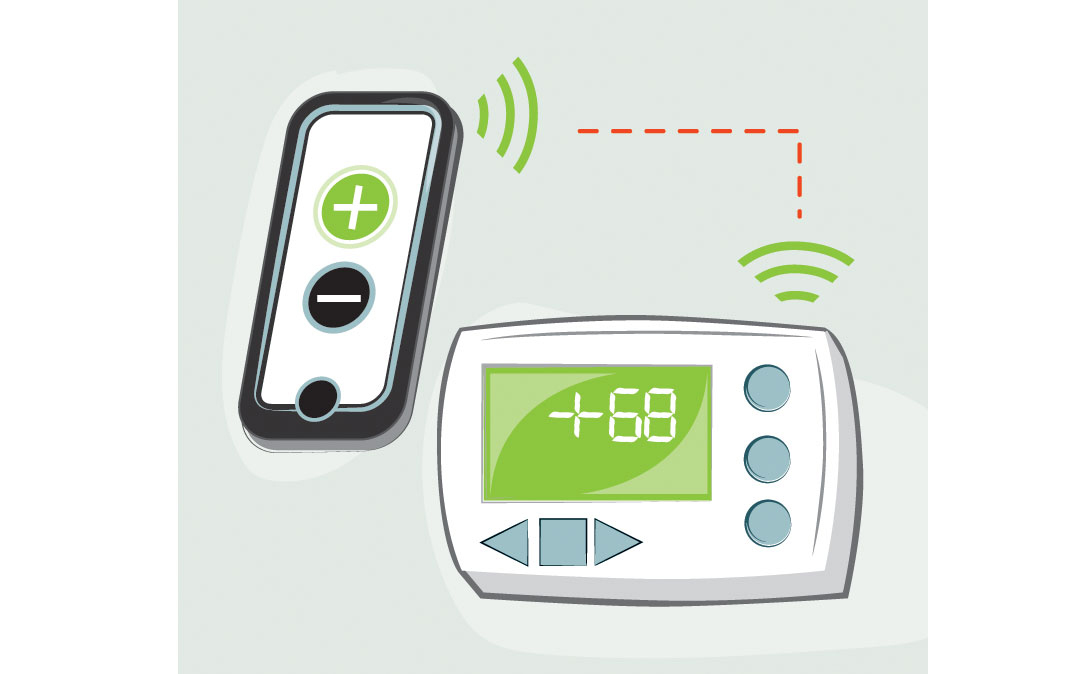 Improvements in heating and air-conditioning systems and insulation have already led to big leaps in energy efficiency. More advancements are coming soon. Thermostats will be fine-tuned remotely with a click of your smartphone. Appliances will go into a sleep mode when not in use. The most efficient homes will generate more electricity than they consume.
Improvements in heating and air-conditioning systems and insulation have already led to big leaps in energy efficiency. More advancements are coming soon. Thermostats will be fine-tuned remotely with a click of your smartphone. Appliances will go into a sleep mode when not in use. The most efficient homes will generate more electricity than they consume.
GROW YOUR OWN
 Just feeding ourselves accounts for 8.4 percent of U.S. greenhouse gas emissions. Localizing our food production—even just a little bit—can help lower the total figure. Homegrown tomatoes taste better than the supermarket offerings and are easier on the environment.
Just feeding ourselves accounts for 8.4 percent of U.S. greenhouse gas emissions. Localizing our food production—even just a little bit—can help lower the total figure. Homegrown tomatoes taste better than the supermarket offerings and are easier on the environment.
EVs FOR EVERYONE
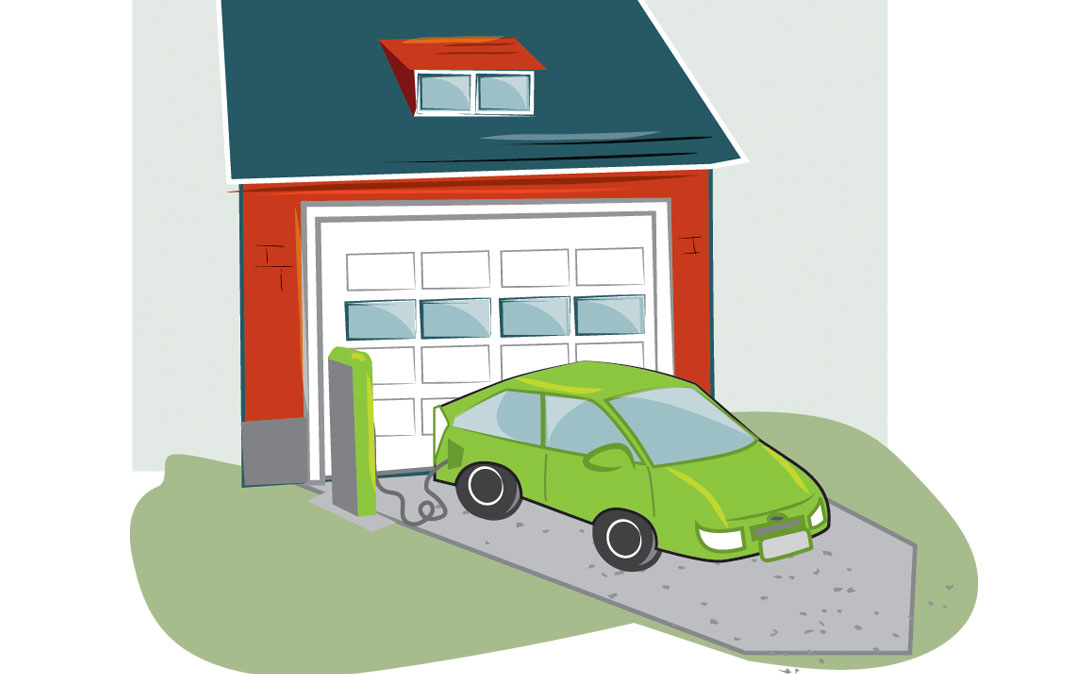 Driverless, electrified, hyperconnected vehicles will slash the amount of energy required to move people around. Increasingly, your car will serve as an energy-storage device as much as a transportation tool. The most likely scenario: Vehicles will take surplus energy from your home and move it to the city center.
Driverless, electrified, hyperconnected vehicles will slash the amount of energy required to move people around. Increasingly, your car will serve as an energy-storage device as much as a transportation tool. The most likely scenario: Vehicles will take surplus energy from your home and move it to the city center.
MY OTHER CAR IS A BIKE
 Coming investments in high-speed rail, urban light rail, and dedicated bus lanes—combined with many cities' push for greater population density and walkable neighborhoods—will reduce the need to use a car for every little errand. The near future will be intermodal: You'll bike to the train and then maybe hop on a bus to get to your final destination.
Coming investments in high-speed rail, urban light rail, and dedicated bus lanes—combined with many cities' push for greater population density and walkable neighborhoods—will reduce the need to use a car for every little errand. The near future will be intermodal: You'll bike to the train and then maybe hop on a bus to get to your final destination.
Illustrations: Cai Sepulis
 The Magazine of The Sierra Club
The Magazine of The Sierra Club



